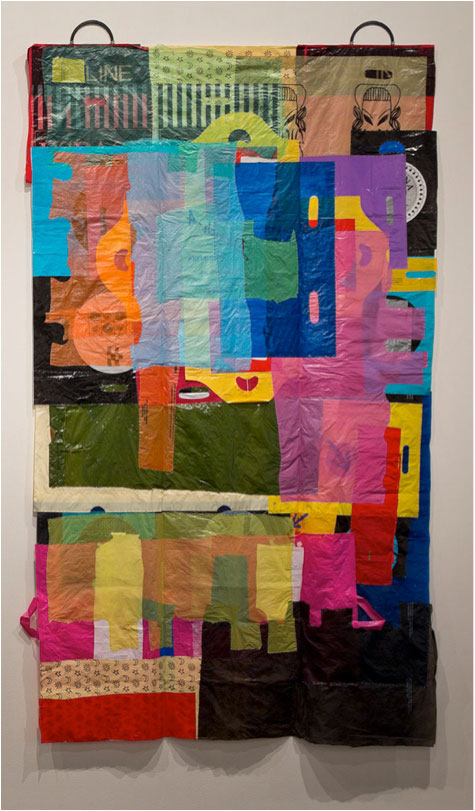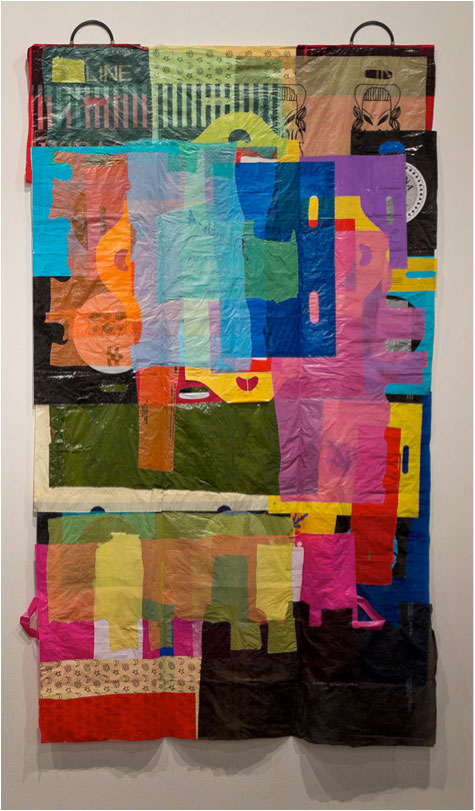 “Postconsumer Mandala” by Dianna Cohen. This art piece, a collage made entirely of plastic shopping bags, sparked the idea to form the Plastic Pollution Coalition, which brings together groups working to stop plastic pollution. (Credit: Dianna Cohen)Our world is made of plastic. From grocery bags to water bottles to food containers, it is nearly impossible to be a consumer in today’s market without producing plastic waste on a daily basis. This plastic is infiltrating our oceans at alarming rates, which could finally force us to address our plastic consumption.
“Postconsumer Mandala” by Dianna Cohen. This art piece, a collage made entirely of plastic shopping bags, sparked the idea to form the Plastic Pollution Coalition, which brings together groups working to stop plastic pollution. (Credit: Dianna Cohen)Our world is made of plastic. From grocery bags to water bottles to food containers, it is nearly impossible to be a consumer in today’s market without producing plastic waste on a daily basis. This plastic is infiltrating our oceans at alarming rates, which could finally force us to address our plastic consumption.
A combination of high functionality and low production costs has made plastic one of the most popular materials in the world. In the past 50 years, plastic use has increased 20 times. If current consumption rates continue, plastic use will double again in the next 20 years.
All of this will result in polluted, poisoned, plastic-filled oceans. According to a recent study by the World Economic Forum, there may be more plastic than fish in the world’s oceans by 2050. In order to combat this, many believe it’s time to reduce our plastic use and even ban certain plastic products outright.
“Reducing plastic waste is a really big issue. Plastic in our oceans affects anything and everything, including all humans and animals,” said Genevieve Abedon, waste prevention campaign coordinator at Californians Against Waste, a nonprofit group that worked on the statewide plastic bag ban and nationwide plastic microbeads ban.
Once plastic enters our oceans, it has a severe impact on the marine environment. Birds, whales, sea turtles and other animals often mistake plastic for food. Scientists are currently researching the long-term impacts of this, including potential impacts on human health.
When plastic doesn’t end up in a marine animal’s stomach, it washes up on beaches, where cleanup crews experience the world’s plastic problems firsthand. According to Alys Arenas, beach programs manager at Heal the Bay, plastic products, especially water bottles and straws, are some of the most prominent items found on beaches. She said that seeing these items at beach cleanup events can inspire volunteers to change their own plastic habits.
“Seeing the amounts and the types of debris we find on our beach is an eye-opener to people,” she said, explaining that volunteers come away not only having picked up some trash, but also having developed a new sense of “what they can do to help to keep our waterways clean.”
The plastic that remains in the ocean typically clumps together to form huge gyres, which are swirling masses that expand both across the ocean’s surface and into its depths. Billions of pounds of plastic have bounded together to form these gyres, which currently cover almost 40 percent of the world’s ocean surfaces. Gyres have long been a focus of research for scientists and, more recently, a muse for artists.
Plastic Art Activism
Photographs of dead seagulls with their stomachs open, exposing swallowed plastic debris. A daunting cornucopia made of plastic materials and spray-painted black, with brightly colored plastics spilling out of it. Dramatic digital images of an Indian man floating on a gigantic raft made entirely of plastic water bottles.
These are just some of the pieces on display at “Gyre: The Plastic Ocean,” an art exhibit currently touring the United States, with stops in Los Angeles, Atlanta and Alaska. The exhibit exclusively showcases pieces involving marine plastic debris.
“A combination of art, science and action can educate, inspire and propel change. This exhibition puts a spotlight on the growing global plastic pollution crisis by featuring a number of fine artists who have become focused on communicating aspects of this global disaster in aesthetic and enticing ways,” said Dianna Cohen, an artist in the exhibit and cofounder of the Plastic Pollution Coalition.
If “more plastic than fish” isn’t a clear enough visualization of the world’s marine plastic pollution problem, the Gyre exhibition certainly is. Cohen’s piece, “Postconsumer Mandala,” is a collage made entirely of plastic shopping bags. Her artwork sparked the idea to form the Plastic Pollution Coalition, which brings together groups working to stop plastic pollution.
“After making art out of plastic bags for more than 20 years, I had come to realize that we have a big problem in the ocean and the world with single-use and disposable plastics,” Cohen said. “Rather than going to the Great Pacific Garbage Patch and cleaning it up, I decided to look at the bigger picture of reducing plastic at the source.”
According to Cohen, reducing the amount of plastic pollution in our oceans will take a combination of personal responsibility, corporate responsibility and public policy.
“We can work toward a plastic-free world through education and through choosing alternatives everyday to single-use plastics,” she said. “We can also do so through extended producer responsibility, regulation and legislation.”
Moving Toward a Solution
Recently, an increase in public interest and political actions has made such legislation a reality.
According to Mark Murray, executive director of Californians Against Waste, “The discovery of the Pacific Gyre brought [marine plastic pollution] to the forefront in terms of California policy issues.”
“Policy makers are recognizing that single-use plastic products are posing a risk to our environment, and one of the strategies they can enact is basically to phase these materials out of the marketplace,” he added.
One such phaseout has been spreading across the state of California: a phaseout of plastic bags. Murray noted that phasing out plastic bags is a somewhat simple transition for consumers to grasp, since their negative environmental impact is obvious.
“The environmental consequences of a plastic bag far exceed [its] utility. You use it for maybe 15 to 20 minutes for groceries, and then your use of it is over, but it continues to persist as pollution in the ocean, landfill or [as a] floating piece of litter in the environment,” he explained.
The same could be said about single-use plastic water bottles, which could easily be replaced by reusable bottles. At least that’s what some college students think; many have taken matters into their own hands and banned the sale of plastic water bottles on their campuses. Harvard University, Seattle University and Dartmouth College are among the more than 90 schools with restrictions on plastic water bottles.
Caylin McKee, the sustainability coordinator in dining services at the University of Vermont, believes that this method could be easily implemented at any college campus, “as long as the university is willing to sacrifice the bottled water contract’s financial contribution.”
Of course, it’s easy to say that simply outlawing plastic altogether would keep it out of our oceans. But realistically, this isn’t possible — so it is necessary for individuals to make small changes to their plastic consumption habits.
“We can all take small steps to change our daily habits, by refusing disposable plastic every day,” said Dianna Cohen, noting that carrying reusable bags and water bottles are easy ways to start.
Note: This article is the winner of the Generation Progress pitching contest judged by Truthout.
Join us in defending the truth before it’s too late
The future of independent journalism is uncertain, and the consequences of losing it are too grave to ignore. To ensure Truthout remains safe, strong, and free, we need to raise $47,000 in the next 8 days. Every dollar raised goes directly toward the costs of producing news you can trust.
Please give what you can — because by supporting us with a tax-deductible donation, you’re not just preserving a source of news, you’re helping to safeguard what’s left of our democracy.
